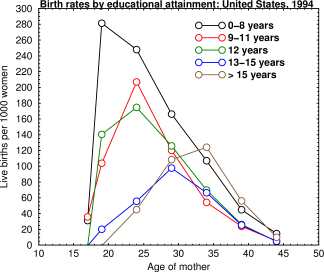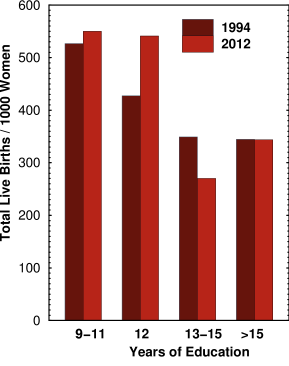 hile everyone is busy worrying about the disaster in Europe, the problem that
led to it—low fertility rates—is happening here as well.
hile everyone is busy worrying about the disaster in Europe, the problem that
led to it—low fertility rates—is happening here as well.
Way back in 1997 a study from the CDC[1] showed a direct relationship between years of education and birth rates, with the highest birth rates among women with the lowest educational attainment.

Birth rates by educational attainment, 1994. Source: CDC
Little has changed in the past two decades. There's been a modest increase in fertility for women who are high school graduates and a compensatory decrease for those with some college. The other groups have stayed pretty much the same.
It's well accepted that any country that incorporates women into the workforce experiences a rapid drop in birth rates. College education reduces it still further. The CDC attributes this to delayed childbearing. This is supported by the US Census data, which showed that women with graduate or professional degrees have slightly higher rates (66 / 1000) than women with high school degrees (57.7 / 1000) in the years after graduation as they try to make up for lost time. However, as the bar graph below shows, they are not entirely successful, and there is still a significant disparity in total number of births.
The trend holds true worldwide: countries with the highest participation of women and highest education of women have the lowest fertility rates. Some countries are in what demographers have called a death spiral.

Total yearly live births for all age groups per 1000 women in 1994 and 2012. Source: US Census, CDC
Years ago a decline in fertility was thought to be beneficial, as there was hope that as so-called developing countries improved they would experience reductions in ‘overpopulation,’ as it was then called.
In Western countries, however, a contradiction developed among the multicultural Left: is not overpopulation a Western concept, they argued, and therefore a way of imposing our values on developing nations? Who are we to define overpopulation? Is not the very concept a form of colonialism?
Progressives thus adopted their own unique solution: tie any discussion of population demographics to race, thereby making it a taboo subject. The progressives' obsession with labeling their all opponents as racist serves mainly to block discussion of the failures of their ideology.
The idea that overpopulation was a pressing problem also faded as advances in technology reduced the threat of pressure on resources. Now underpopulation is a serious problem.
Since education within a population correlates strongly with intelligence, the disparity means that high intelligence will eventually become rare commodity. Many people think evolution occurs at a glacial pace, but the disparities shown here are large enough to produce changes in only a few generations. In an increasingly complex, mechanized, and technical world, what will happen to the millions who are unable to contribute?
Populations can be disenfranchised as effectively by lack of skill as by oppression. Those deprived of the chance to participate in economic growth will sooner or later realize they have no stake in the game—no incentive to help keep the society functional. On the contrary, they may have more to gain by advocating its destruction. Some historians have suggested that something like this may have happened to the Roman Empire.
Whether that is true or not, it is a dilemma for the West and for those societies, like Japan, that have adopted Western values. On the one hand, they cannot now reject the values of equality of opportunity and equal rights. They cannot remain liberal democracies while forcing women to bear equal numbers of children, even if such a thing were possible. On the other hand the most basic drive for a culture, just as for individuals, is survival.
Astronomer Carl Sagan famously worried that all advanced civilizations immediately self-destruct. He was not, of course, thinking about demography; but extinction can happen in any number of ways, some slower than others. Is it possible that it is the universal fate of civilized nations to grant women equal rights and then, shortly thereafter, go extinct? An admittedly provocative question. But Nature does not care much about our noble ideals and cares even less about equality. For Nature, the only thing that counts is numbers.
One solution would be to make it easier for women in educational institutions to bear and raise children. But the cultural pressures might still outweigh the inconvenience: college is still seen by many as an extension of childhood. This must change.
There are, of course, other solutions, but none is particularly palatable: we could start manufacturing test-tube babies. Or we could invent artificial intelligence and turn the task of exploring the universe to them. Or we could do nothing and hope some as-yet undiscovered survival instinct gene kicks in.
The only other alternative is to find a way of making women smarter, say with a memory-enhancing pill, so they can complete college in zero to eight years. But anyone who has had to teach them knows that, as desirable as it may be, making women smarter—or men, I hasten to add—is not easy.
1. U.S. Center for Disease Control and Prevention (Monthly Vital Statistics report 45(10), suppl, 1997). Source
